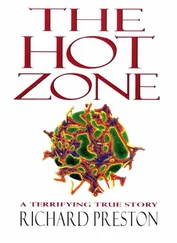The HPRT gene is found on the X chromosome, which is the female sex chromosome and carries information that makes the person female. Women have two X chromosomes in each cell, and men have an XY pair. Lesch-Nyhan is an X-linked recessive disorder. This means that if a bad HPRT gene on one X chromosome is paired with a normal gene on the other X chromosome, the disease will not develop. A woman who has the Lesch-Nyhan mutation but carries it on only one of her X chromosomes doesn’t develop the syndrome. Any son she has, however, will have a 50 percent chance of inheriting the syndrome (if he gets the bad X chromosome, he will have the disease; if he gets the good one, he won’t), and any daughter will have a 50 percent chance of being a carrier. (Examples of this type of X-linked recessive disease include hemophilia and a form of red-green color blindness. Queen Victoria was a carrier of the hemophilia gene, but she didn’t have hemophilia. Some of her male descendents had it.)
Other genetic mutations have been associated with profound behavioral changes. Rett syndrome, which affects mostly girls, is caused by a mutation in a gene that codes for the MeCP2 protein. People with the syndrome compulsively wring their hands and rub them together as if they were washing them. Children with Williams syndrome have an elfin appearance, an affinity for music and language, an extreme sensitivity for sound, and are very sociable. Williams syndrome is caused by a deletion of a bit of code from chromosome 7.
There is still great uncertainty about how much of a role genes play in major, common conditions such as depression or bipolar disorder. One wonders where obsessive-compulsive disorders come from, or such behaviors as compulsive hand-washing, compulsive neatness. Do some people suffer from OCDs that are caused by misspellings in their code? What about borderline personality disorder? How many mental illnesses are the result of errors in the code or certain combinations of errors? No one knows. It seems quite evident that a lot of human behavior is affected or governed by the blueprint of a person’s DNA. Even where there is evidence of a family history of disease, scientists are unsure how a single gene could choreograph a suite of behaviors. There are roughly twenty-five thousand active genes in the human genome, each with about a thousand to fifteen hundred letters of code. The human genome could be thought of as a kind of piano with twenty-five thousand keys. In some cases, a few keys may be out of tune, which can cause the music to sound wrong. In other cases, if one key goes dead the music turns into a cacophony or the whole piano self-destructs.
The havoc that the Lesch-Nyhan mutation causes cannot easily be undone. Early on, Nyhan tried giving his Lesch-Nyhan patients allopurinol, a drug that inhibits the production of uric acid. The drug is effective with gout. It lowered the concentration of uric acid in Lesch-Nyhan patients, but it didn’t reduce their self-injurious actions. The uric acid, it seemed, was another symptom, not a cause of the behavior.
Nyhan experimented with simple treatments, such as soft restraints, which seemed to relax patients and made them feel safer from themselves. Matthew Morlen had frequently asked to be tied into his stringlyjack. Nyhan also began recommending that Lesch-Nyhan children have their upper teeth removed, so that they couldn’t bite off their lips and tongues as easily. “I’m profligate with those upper teeth,” he said. This led to arguments with dentists. Some dentists would refuse to extract healthy teeth, even when the Lesch-Nyhan syndrome was explained to them.
I was visiting Nyhan in his office, and there was a lull in the conversation. He sat back in his chair and looked at me. I couldn’t tell what he was thinking. Outside the window, the hawks were still riding thermals over the canyon. We had come to the end of knowledge about Lesch-Nyhan. The disease remained as mysterious and frightening as it had seemed on the day when Nyhan and Lesch had first seen it, nearly forty years earlier. But I had never seen it. “I can’t imagine what it’s like to have Lesch-Nyhan,” I finally said to him.
“You could ask someone who has it,” he replied.
* * *
I MET JAMES ELROD and Jim Murphy one winter day not long afterward. They were living next to each other in rented bungalows in a somewhat marginal neighborhood in Santa Cruz, California. James Elrod was then in his early forties, and Jim Murphy was just over thirty. They were close friends, except when their Lesch-Nyhan symptoms annoyed each other. (Murphy died in 2004; Elrod, who is fifty as I write this, became one of the oldest living people with Lesch-Nyhan.) The men were clients of Mainstream Support, a private company contracted by the state of California to help people with developmental disabilities live in community settings. Before he came to to Santa Cruz, James Elrod lived for eighteen years in a state institution in San Jose called the Agnews Developmental Center. Jim Murphy had spent all of his adult life in a California state institution in Sonoma. Mainstream employees, called direct-care staff, stayed with Elrod and Murphy around the clock, to help them with daily tasks and to make sure they didn’t harm themselves. Elrod and Murphy had the authority to hire and fire their assistants and direct their work, though an assistant could refuse an order if he thought it would put the client in danger.
At the time, Mainstream was run by two business partners, Andy Pereira and Steve Glenn. “James and Jimmy are real down and gritty guys,” Pereira said. “They are not sweet types. They’re into fast cars and women.” Steve Glenn confessed that he still had difficulty seeing into the labyrinth of Lesch-Nyhan. “There are these Lesch-Nyhan moments when you feel like you’ve kind of got it,” he said. “James and Jimmy are pretty good at telling you when they think they’re in danger of hurting themselves, but whenever they’re doing something, you always have to ask, Is this James or Jimmy, or is it Lesch-Nyhan?”
James Elrod had a square, good-looking face, which was marked with scars, and he had brown, hyperalert eyes. His shoulders and arms were large and powerful, but the rest of his body seemed slightly diminished. One day at the Agnews Developmental Center, before he was with Mainstream, an attendant left him alone at a dining table for a few minutes. To his horror, his left hand picked up a fork and used it to stab his nose and gouge it out, removing most of his nose and permanently mutilating his face. “My left side is my devil side,” he told me. When I met him, he wore black leather motorcycle gloves that had been reinforced with Kevlar. If he thought his left hand was threatening him or someone else, he would grab it or swat it with his right hand. He owned a pickup truck, and his assistants drove him around in it. He had a job working at a recycling facility. He also used to sell flowers on the Santa Cruz pier. He carried business cards explaining that he had a rare disease that compelled him to hurt himself. “I have injured myself in many ways including my nose, as you can see,” the card said. “I will even try to hurt myself by getting into trouble with others.” One day, a man bought some flowers from Elrod and said, “God bless you.” “Eat shit,” Elrod replied, and handed the man his business card. While crossing a street in his wheelchair, Elrod had been known to suddenly roll himself straight into oncoming traffic, yelling, “Slow down, you morons! Don’t you know it’s Lesch-Nyhan?” His assistants wrestled him to safety.
Elrod was sitting in front of his house in his wheelchair when I arrived. It was a sunny day. He offered me his right hand to shake. When I gripped his glove, the right index finger collapsed. “You broke my finger!” he gasped. Then he grinned and explained that he didn’t have that finger, as he had bitten it off some time ago.
Читать дальше








![Shin_Stark - В подземелье я пойду, там свой level подниму X [СИ]](/books/384602/shin-stark-v-podzemele-ya-pojdu-tam-svoj-level-po-thumb.webp)



